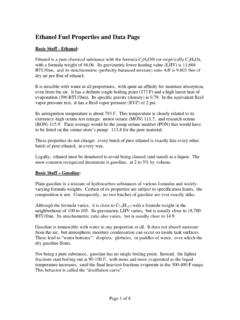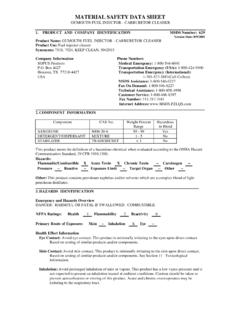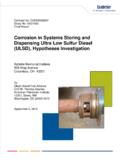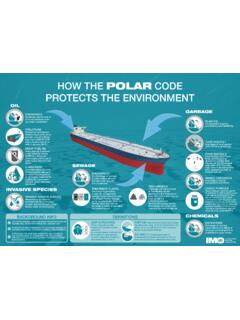Transcription of Microbial Contamination of Diesel Fuel: Impact, …
1 Application ProfileMicrobial Contamination of Diesel Fuel: impact , Causes and PreventionGeneralThere is an interesting paradox regarding the Microbial Contamination of Diesel papers, symposia and other reports have thoroughly documented the adverseimpact of Microbial Contamination in Diesel fuels. A variety of products and procedures areavailable for minimizing this impact . Yet, of the nearly 12 billion gallons of Diesel fuelconsumed annually in the United States,1less than one percent is treated with anantimicrobial agent. One explanation for this paradox is that few truck, ship or railroad fleetoperators recognize the economic impact of uncontrolled Microbial Contamination . Theeffects of Microbial Contamination are often subtle, and are rarely identified by systemoperators as the cause of defined fuel -performance stability purpose of this Application Profile is three-fold. The first section will address the impactof uncontrolled Microbial Contamination of Diesel fuels.
2 Its objective is to show theconnection between a variety of performance problems and Microbial growth in dieselsystems. In order to control Contamination successfully, operators must understand itscauses and dynamics, which will be the focus of the second section. The remainder of thepaper will address approaches for preventing and curing Microbial ofProblems arise from both the direct and indirect effects of Microbial growth in Diesel tanks. Microbial Table 1 summarizes direct 1 Metabolic attack on hydrocarbon and additive moleculesDirect Effects Surfactant metabolite productionof Microbial Organic acid productionContamination of Sulfate reduction/sulfide productionDiesel Fuels Biomass production Biofilm formationVirtually all Diesel fuel contains some moisture. Additional water accumulates in tanks asatmospheric moisture condenses. Moisture accumulates in Diesel tanks as condensatedroplets on exposed tank surfaces, as dissolved water in the fuel and as water bottomsbeneath the fuel (Figure 1 - see page 2).
3 As will be discussed later, microbes depend on thiswater for growth. Additionally, microbes depend on the organic and inorganic molecules indiesel fuel for nutrition. Consequently, some species attack the fuel directly, growing at theexpense of hydrocarbons and non-hydrocarbon fuel components. The biodegradation offuel, in support of Microbial growth, is a direct impact of Contamination . Color, heat ofcombustion, pour point, cloud point, detergent and anti-corrosive properties change asmicrobes selectively attack fuel components. Sulfur-containing molecules are metabolizedby a series of species, leading ultimately to the production of high concentrations ofhydrogen sulfide. In addition to creating new cells, many microbes produce metaboliteswhich promote further attack. Surfactants facilitate the emulsification of fuel , leading to theformation of a cloudy, invert-emulsion layer above the Fuel: water interface (Figure 2).Page 1 of 17 Form No.
4 253-01246-10/01/03 Polysaccharide slimes create microenvironmentswherein mixed populations (consortia)of bacteria and fungi carry out biodegradation reactions that would be impossible for a singlespecies outside the slime also serves as a barrier, protecting themicrobes from preservatives. A variety of organic acids (primarily 2 - 4 carbon atoms) arealso produced as by-products of bacterial and fungal growth. As the acids accumulate, theycause a number of indirect effects. These effects will be considered later in this 1 Fungal growth atfuel:waterinterface, in adiesel fuel 2 Invert emulsionlayer forming indiesel fuel abovebiofilm which isgrowing 3 Example ofbiomassaccumulation onfuel tank 2 Microbially influenced corrosionIndirect Effects Sludge formationof Microbial Organic acid accumulationContamination of Hydrogenase-caused depolarization of metallic surfacesDiesel Fuels Transfer-line flow restrictions Filter plugging Engine wear Corrosive deposits on engine parts (injectors, cylinder linings, etc.)
5 Reduced heat of combustionPage 2 of 17 Form No. 253-01246-10/01/03 fuel property changes: color, pour point, cloud point, thermal stability Loss of additive performanceAs bacteria and fungi reproduce, they form biomass,which accumulates at the Fuel: waterinterface, on tank surfaces and on filters (Figure 3). The development of biomass is a directconsequence of Microbial growth. Its effect on fuel systems is mostly are several important indirect effects of biomass and slime production, assummarized in Table 2. As biomass turns over, and as metabolic waste and dead cellsaccumulate, they settle out as sludge which accumulates on tank bottoms (Figures 4a, 4b).The appearance and composition of this sludge may be quite variable, but the presence oflarge numbers of microorganisms is nearly universal. The types of microbes dominating aparticular sludge appear to depend on the physical-chemical conditions of the sludge. Theimportant issue here is the accumulation of a mass, beneath which microbially influencedcorrosion (MIC),sulfide production and organic acid accumulation ,4,5If sufficientsludge builds up, sludge particles will be drawn out with the Diesel fuel .
6 As a result, filtersand injector orifices may become often, filter and line plugging result from biofilm formation on transfer-line walls andfilter-matrix surfaces. The first symptom of this is reduced filter-life. Often, in operationswhere chronic Microbial Contamination goes unrecognized, reduced filter life also 4aExample of sludgebuild-up at thebottom of a fuelstorage 4bClose-up of thesludgeaccumulationshown in 3 of 17 Form No. 253-01246-10/01/03 Figure 5aExample of fuelfilter fouled withbiomassaccumulation;whole 5bClose-up ofbiofouled filtershown in is only after biomass production is inhibited, and the consequent prolongation of filter lifeis discovered, that the existence of the previous problem is ,catastrophic failures, like engine shut-down due to fuel starvation, provide convincingevidence of the importance of Contamination control. One of the more sinister aspects of thefilter-plugging problem is that often the biofilm is nearly transparent.
7 Consequently itgenerally goes unnoticed. Only rarely does one see the kind of biomass accumulationillustrated in Figures 5a and , indirect effect of flow restriction is increased engine flowcauses variation in combustion within cylinders. Increased piston and cylinder wear ratesand increased torque on camshafts translate into increased maintenance costs. Enginefailure due to fuel starvation can be a particularly embarrassing consequence of it happens to an aircraft engine during flight, or a marine Diesel during operations inrestricted waters or heavy seas, the impact can be catastrophic. As anti-corrosive additivesare biodegraded, and organic acids accumulate in fuel , the probability of corrosion depositson pistons, cylinders and injectors , conducive to MIC, may be produced throughout any storage or servicetank. Volatile organics in the vapor phase above stored fuel are absorbed by condensatedroplets, providing an excellent environment for biofilm formation on exposed tank tears or openings in tank surface coatings provide niches for microbes to growbetween the coating and tank surfaces.
8 Further compromise of the coating follows, oftenaccompanied by MIC of the tank walls. This phenomenon can also occur at the Fuel: tank-surface and the bottoms water:tank-surface interfaces, where dissolved organic moleculesand other nutrients are ,11,12In summary, uncontrolled Microbial Contamination of Diesel fuels has a significant directadverse economic impact at every phase of the fuel production, transport, storage andconsumption industries. Degradation of Diesel fuel can begin during interim storage at therefinery. Often, Contamination processes which start at this stage go undetected until fleetoperators experience problems. Microbes attack the fuel and additives directly. They alsocause secondary problems, including sludge formation, fouling and corrosion. Tank-farmmaintenance and fleet operations costs can be reduced substantially by controllingcontamination before the problems occur. In the next section, we will review the causes anddynamics of Microbial Contamination in fuel 4 of 17 Form No.
9 253-01246-10/01/03 Microbial To control Microbial Contamination successfully, an operator must have a clear idea of what Contamination kinds of microbes contaminate fuel , where they come from, and how and why they grow in Its Nature fuel systems. While the answers to the what, where, how and why questions are complex, and Sourcesit is possible for the field operator and engineer to become sufficiently familiar with the basicconcepts to be able to make sound Contamination -control major groups of microorganisms contaminate fuel systems; bacteria and fungi. Bacteriaare single-cell organisms that lack a membrane-bound nucleus. In contrast, fungi do have adefined nucleus. The nucleus is the organelle which contains most of the cell s 3 lists the bacteria and fungi most commonly recovered from Diesel fuel andassociated water bottoms. Note that the fungi can be divided into two groups: filamentousmolds and single-cell yeasts. Taxonomic classification does not provide a great deal ofinformation about what the microbes do.
10 It is important to differentiate between bacteria andfungi because they are structurally very different, and therefore respond to 3 BacteriaFungiBacteria and Pseudomonasspecies1 Hormoconis resinae2 Fungi CommonlyFlavobacteriumspeciesFusariumspe ciesRecovered fromSarcinaspeciesCandidaspeciesDiesel FuelDesulfovibriospeciesAspergillusspeci esDesulfotomaculumspeciesHydrogenomonass peciesClostridiumspeciesNotes: 1) The term species indicates that various species of the genus are routinely : 2) Hormoconisis the current name given to the fungus formerly classified as alternative approach to classifying microbes in fuel systems is by their activities oroxygen requirements. Bacteria that require oxygen are called obligate are introduced into fuel systems along with other contaminants, but will die offunless a minimum concentration of free oxygen is available to them. In contrast, obligateanaerobescannot grow in the presence of oxygen.






